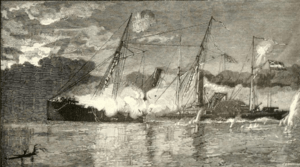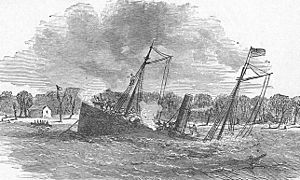USS Varuna (1861) facts for kids

USS Varuna rammed by CSS Stonewall Jackson
|
|
Quick facts for kids History |
|
|---|---|
| Namesake | Varuna |
| Builder | Mallory Yard, Mystic, Connecticut |
| Laid down | January or February 1861 |
| Launched | September 1861 |
| Acquired | 31 December 1861 |
| Commissioned | February 1862 |
| Out of service | 24 April 1862 |
| Fate | Sunk in action 24 April 1862 |
| General characteristics | |
| Tons burthen | 1,247 tons burthen or 1,300 tons |
| Length | 218 ft (66 m) |
| Beam | 34 ft 8 in (10.57 m) |
| Depth of hold | 18 ft 3 in (5.56 m) |
| Propulsion |
|
| Complement | 157 |
| Armament |
|
The USS Varuna was a screw steamer (a ship powered by a propeller) used by the Union Navy during the American Civil War. It was still being built in 1861 when the Union Navy bought it on December 31. After being officially put into service in February 1862, Varuna joined the West Gulf Blockading Squadron.
Varuna was part of a big attack led by Flag Officer David Farragut on April 24, 1862. This attack was against Confederate forts named Fort Jackson and Fort St. Philip. During the battle, Varuna sped ahead of the other Union ships. It ended up chasing a Confederate gunboat called Governor Moore. The Governor Moore rammed Varuna twice, and another Confederate gunboat, CSS Stonewall Jackson, hit it a third time. Varuna sank in just 15 minutes. Even though Varuna was lost, Farragut's fleet successfully captured the city of New Orleans, Louisiana.
Building the Varuna
The American Civil War started in April 1861. The Union (the northern states) planned to block off the Confederate coastline. They also wanted to control the Mississippi River. At the start of the war, the Union Navy only had 42 active ships. Many other ships were old or in bad shape. Also, many of the active ships were too big to enter the ports they needed to block. The Union needed many new ships quickly to meet their goals.
The Varuna was named after a Vedic god linked to the skies and seas. Its construction started in January or February 1861 at the Mallory Yard in Mystic, Connecticut. The ship was launched in September 1861. It was first meant to be a merchant ship, carrying goods between New York City and New Orleans, Louisiana. However, the Union Navy bought Varuna on December 31, 1861, in New York City, before it was even finished.
The Varuna was 218 feet (66 m) long and 34 feet 8 inches (10.57 m) wide. Its depth of hold was 18 feet 3 inches (5.56 m). It was a steamship powered by a single screw propeller. The ship had a crew of 157 sailors. For weapons, it carried eight 8-inch (20 cm) Dahlgren guns and two 30-pound (14 kg) Parrott rifles. These were powerful cannons used during the Civil War.
Varuna's Time in Service
The Varuna was officially put into service in February 1862. On February 10, it was briefly ordered to wait in New York City. The plan was for Varuna to escort the ironclad ship USS Monitor to Hampton Roads. However, this order was changed later that day. Instead, Varuna became part of the West Gulf Blockading Squadron. On its way to join the squadron, Varuna stopped at Port Royal, South Carolina. Varuna finally joined the West Gulf Blockading Squadron on March 6.
In January, Flag Officer David Farragut was given the job of capturing New Orleans for the Union. Farragut had a fleet of warships and a special Mortar Flotilla. In late February, he arrived at Ship Island, a key island off the coast of Mississippi. After getting ready, the fleet started moving up the Mississippi River towards New Orleans on April 15.
The mortars from the Mortar Flotilla began firing at two Confederate forts near New Orleans. These were Fort Jackson and Fort St. Philip. The shelling started on April 18 and lasted for five days. Union ships managed to break through a barrier in the river on April 20. Then, at 2:00 AM on April 24, Farragut's ships began their attack on the two forts. This started the Battle of Forts Jackson and St. Philip.
Varuna Sinks in Battle

Farragut sent 17 warships to attack the forts. He split them into three groups. Varuna was one of eight ships in the first group. Their job was to move up the eastern side of the river and attack Fort St. Philip. The Confederate forts started firing around 3:40 AM. The first Union ship was USS Cayuga. It moved towards Fort St. Philip and fought against the Confederate ironclads CSS Louisiana and CSS Manassas.
Varuna also fired its guns, hitting both Union and Confederate ships. USS Oneida came to help Cayuga. While Oneida stayed and fired at the forts, Varuna broke away and kept going upriver. It had engine trouble and low boiler pressure, but it pushed on. Varuna met a group of Confederate gunboats and fired at them, then continued upriver.
Varuna was now the lead Union ship. The Confederate gunboat Governor Moore spotted it. Union ships showed a certain color light on their masthead, which helped the Confederates identify them. The two ships began a chase upriver. Governor Moore fired its front gun, while Varuna fired its back gun. Another gunboat, CSS Jackson, briefly fired into the fight, then continued towards New Orleans.
Varuna tried to turn its side to fire all its guns at Governor Moore. But Governor Moore stopped this move. The two ships fired at each other from only 40 yards (37 m) away. Governor Moore got even closer. Its front gun couldn't aim low enough to hit Varuna's deck. So, its captain ordered the gun to be fired through their own deck, making a new hole to shoot from. A second shot through this hole killed three men on Varuna and wounded others.
At this point, the ships were only about 10 feet (3.0 m) apart. They could barely see each other because of the thick smoke. It was around 6:00 AM, and they were about 9 miles (14 km) upriver from the forts. Varuna turned to its starboard (right) side to fire all its guns. This attack caused a lot of damage on Governor Moore's deck. But Governor Moore rammed Varuna, knocking out the Union ship's engines.
Governor Moore then backed away and rammed Varuna again. Varuna was sinking fast and headed towards the riverbank. Then, the gunboat CSS Stonewall Jackson arrived and rammed Varuna one last time. Varuna sank within 15 minutes, still firing its guns as it went down. Eight sailors from Varuna later received the Medal of Honor for their bravery in this battle. Governor Moore was also sunk by its own crew shortly after its victory over Varuna.
By mid-morning, Farragut had 13 of his ships past the forts. Most of the Confederate ships had been sunk. The two forts surrendered on April 28 after their soldiers refused to fight anymore. After defeating Confederate defenses at Chalmette on April 25, the Union ships entered New Orleans. The fall of New Orleans was a huge loss for the Confederates. The Dictionary of American Naval Fighting Ships (DANFS) says that Varuna "contributed greatly" to the Union victory. A poet named George Henry Boker even wrote a poem about the ship. Parts of its wreck could still be seen in 1885. In 1981, an expedition led by Clive Cussler found a signal near where the ship is thought to have sunk.
Images for kids



